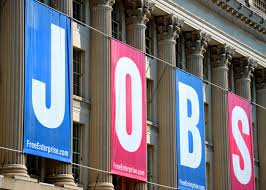
The US economy continues to steam along and create jobs. Alas our website was designed for Europe we will be adding other sections when we redevelop it later.
Total nonfarm payroll employment rose by 157,000 in July, and the unemployment rate edged down to 3.9 percent, the U.S. Bureau of Labor Statistics reported today. Employment increased in professional and business services, in manufacturing, and in health care and social assistance.
Household Survey Data
In July, the unemployment rate edged down by 0.1 percentage point to 3.9 percent, following an increase in June. The number of unemployed persons declined by 284,000 to 6.3 million in July.
Both measures were down over the year, by 0.4 percentage point and 676,000, respectively.
Among the major worker groups, the unemployment rates for adult men (3.4 percent) and Whites
(3.4 percent) declined in July. The jobless rates for adult women (3.7 percent), teenagers (13.1 percent), Blacks (6.6 percent), Asians (3.1 percent), and Hispanics (4.5 percent) showed little or no change over the month.
Among the unemployed, the number of reentrants to the labor force decreased by 287,000 in July to 1.8 million, following an increase in June. (Reentrants are persons who previously worked but were not in the labor force prior to beginning their job search.)
The number of long-term unemployed (those jobless for 27 weeks or more) was essentially unchanged at 1.4 million in July and accounted for 22.7 percent of the unemployed.
The labor force participation rate, at 62.9 percent in July, was unchanged over the month and over the year. The employment-population ratio, at 60.5 percent, was little changed in July but has increased by 0.3 percentage point over the year.
The number of persons employed part time for economic reasons (sometimes referred to as involuntary part-time workers) was little changed in July, at 4.6 million, but was down by 669,000 over the year. These individuals, who would have preferred full-time employment, were working part time because their hours had been reduced or they were unable to find full-time jobs.
In July, 1.5 million persons were marginally attached to the labor force, little different from a year earlier. (Data are not seasonally adjusted.) These individuals were not in the labor force, wanted and were available for work, and had looked for a job sometime in the prior 12
months. They were not counted as unemployed because they had not searched for work in the 4 weeks preceding the survey.
Among the marginally attached, there were 512,000 discouraged workers in July, little changed from a year earlier. Discouraged workers are persons not currently looking for work because they believe no jobs are available for them. The remaining 1.0 million persons marginally attached to the labor force in July had not searched for work for reasons such as school attendance or family responsibilities.
Establishment Survey Data
Total nonfarm payroll employment increased by 157,000 in July, compared with an average monthly gain of 203,000 over the prior 12 months. In July, job gains occurred in professional and business services, in manufacturing, and in health care and social assistance.
Employment in professional and business services increased by 51,000 in July and has risen by 518,000 over the year. Over the month, employment edged up in temporary help services (+28,000) and in computer systems design and related services (+8,000).
Manufacturing added 37,000 jobs in July, with most of the gain in the durable goods component.
Employment rose in transportation equipment (+13,000), machinery (+6,000), and electronic instruments (+2,000). Over the past 12 months, manufacturing has added 327,000 jobs.
In July, employment in health care and social assistance rose by 34,000. Health care employment continued to trend up over the month (+17,000) and has increased by 286,000 over the year.
Hospitals added 7,000 jobs over the month. Within social assistance, individual and family services added 16,000 jobs in July and 77,000 jobs over the year.
Employment in food services and drinking places continued to trend up over the month (+26,000).
Over the year, the industry has added 203,000 jobs.
Construction employment continued to trend up in July (+19,000) and has increased by 308,000 over the year.
In July, employment in retail trade changed little (+7,000). Job gains occurred in general merchandise stores (+14,000), clothing and clothing accessories stores (+10,000), and food and beverage stores (+8,000). These employment gains were offset by a decline of 32,000 in sporting goods, hobby, book, and music stores, reflecting job losses in hobby, toy, and game stores.
Employment showed little or no change over the month in other major industries, including mining, wholesale trade, transportation and warehousing, information, financial activities, and government.
The average workweek for all employees on private nonfarm payrolls decreased by 0.1 hour to 34.5 hours in July, following an increase of 0.1 hour in June. In manufacturing, both the workweek and overtime were unchanged in July, at 40.9 hours and 3.5 hours, respectively. The average workweek for production and nonsupervisory employees on private nonfarm payrolls remained at 33.8 hours.
In July, average hourly earnings for all employees on private nonfarm payrolls rose by 7 cents to $27.05. Over the year, average hourly earnings have increased by 71 cents, or 2.7 percent.
Average hourly earnings of private-sector production and nonsupervisory employees increased by 3 cents to $22.65 in July.
The change in total nonfarm payroll employment for May was revised up from +244,000 to +268,000, and the change for June was revised up from +213,000 to +248,000. With these revisions, employment gains in May and June combined were 59,000 more than previously reported. (Monthly revisions result from additional reports received from businesses and government agencies since the last published estimates and from the recalculation of seasonal factors.) After revisions, job gains have averaged 224,000 per month over the last 3 months.

image: US Jobs market continues to add jobs.
ABC Comment: have your say below:

Leave a comment
Make sure you enter all the required information, indicated by an asterisk (*). HTML code is not allowed.
Join
FREE
Here










